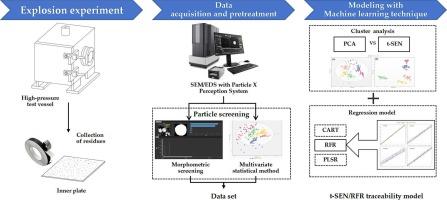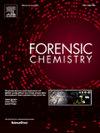机器学习增强了烟火爆炸后残留物的可追溯性和颗粒分析
IF 2.2
3区 医学
Q2 CHEMISTRY, ANALYTICAL
引用次数: 0
摘要
光谱学和色谱学等现代技术使烟火前体分析技术得到了发展,但对爆炸后残留物的法医调查方法仍然有限,从而制约了爆炸源的鉴定。烟火爆炸后残留物(PPERs)保留了化学计量特征,可以通过机器学习增强的扫描电子显微镜/能量色散x射线光谱(SEM/EDS)分析将其与前体配方联系起来,为进一步的法医研究提供基础。本研究提出了一种系统的PPERs分析方法,包括三个关键组成部分:(1)开发一个测试容器和PPERs颗粒收集系统;(2)采用包含粒子X感知系统的自动化SEM/EDS方案进行高通量元素和形态表征(每个样品15,000-38,000个粒子),以及包括形态测定筛选标准和多元统计方法的数据预处理分析方案;(3)构建融合t分布随机邻居嵌入(t-SNE)降维和随机森林回归(RFR)预测建模的机器学习框架。混合模型显示了优异的聚类性能(归一化互信息(NMI) >;0.80),预测精度高(R2 >;0.95,均方根误差(RMSE) <;0.07),支持从扫描电镜/能谱仪数据的烟火可追溯性的潜力。本文章由计算机程序翻译,如有差异,请以英文原文为准。

Machine learning-enhanced traceability and particle analysis of pyrotechnic post-explosion residues using SEM/EDS
Mordern techniques such as spectroscopic and chromatographic techniques have advanced pyrotechnic precursor analysis, yet the forensic investigation methods of post-detonation residues remains limited, thereby constraining the identification of explosive sources. Pyrotechnic post-explosion residues (PPERs) retain stoichiometric signatures that can be linked to precursor formulations through machine learning-enhanced scanning electron microscopy / energy-dispersive X-ray spectroscopy (SEM/EDS) analysis, offering a foundation for further forensic study. This study presents a systematic approach to PPERs analysis with three key components: (1) the development of a test vessel and particles collection system for PPERs; (2) the employment of an automated SEM/EDS protocol incorporating the Particle X Perception System for high-throughput elemental and morphological characterization (15,000–38,000 particles per sample), and a data pretreatment analytical protocol that included morphometric screening criteria and multivariate statistical methods; (3) the construction of a machine learning framework integrating t-distributed Stochastic Neighbor Embedding (t-SNE) for dimensionality reduction and Random Forest Regression (RFR) for predictive modeling. The hybrid model demonstrated excellent clustering performance (Normalized Mutual Information (NMI) > 0.80) and high predictive accuracy (R2 > 0.95, Root Mean Squared Error (RMSE) < 0.07), supporting the potential for pyrotechnical traceability from SEM/EDS data of PPERs.
求助全文
通过发布文献求助,成功后即可免费获取论文全文。
去求助
来源期刊

Forensic Chemistry
CHEMISTRY, ANALYTICAL-
CiteScore
5.70
自引率
14.80%
发文量
65
审稿时长
46 days
期刊介绍:
Forensic Chemistry publishes high quality manuscripts focusing on the theory, research and application of any chemical science to forensic analysis. The scope of the journal includes fundamental advancements that result in a better understanding of the evidentiary significance derived from the physical and chemical analysis of materials. The scope of Forensic Chemistry will also include the application and or development of any molecular and atomic spectrochemical technique, electrochemical techniques, sensors, surface characterization techniques, mass spectrometry, nuclear magnetic resonance, chemometrics and statistics, and separation sciences (e.g. chromatography) that provide insight into the forensic analysis of materials. Evidential topics of interest to the journal include, but are not limited to, fingerprint analysis, drug analysis, ignitable liquid residue analysis, explosives detection and analysis, the characterization and comparison of trace evidence (glass, fibers, paints and polymers, tapes, soils and other materials), ink and paper analysis, gunshot residue analysis, synthetic pathways for drugs, toxicology and the analysis and chemistry associated with the components of fingermarks. The journal is particularly interested in receiving manuscripts that report advances in the forensic interpretation of chemical evidence. Technology Readiness Level: When submitting an article to Forensic Chemistry, all authors will be asked to self-assign a Technology Readiness Level (TRL) to their article. The purpose of the TRL system is to help readers understand the level of maturity of an idea or method, to help track the evolution of readiness of a given technique or method, and to help filter published articles by the expected ease of implementation in an operation setting within a crime lab.
 求助内容:
求助内容: 应助结果提醒方式:
应助结果提醒方式:


